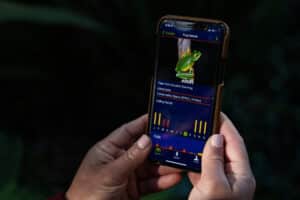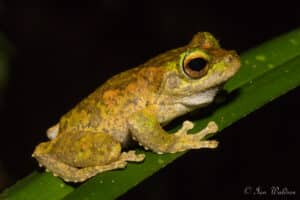One of the most important global meetings on wildlife trade has just wrapped up in Uzbekistan. It’s capital city Samarkand was where governments convened for the 20th Conference of the Parties (CoP20) to the Convention on International Trade in Endangered Species of Wild Fauna and Flora (CITES) to decide how international trade should be managed for some of the world’s most threatened...
Have you ever heard a ribbit, croak or bleat echoing from your backyard on a humid spring night and wondered who it belonged to?
Did you know that there is an app that can not only identify which frog species is calling but also contributes your data to national frog research?
The FrogID app was created by the Australian Museum in collaboration with frog researchers. The genius nature of this application is that it is a simple acoustic monitoring method that uses a tool that fits in your pocket: your smartphone. Users can record frog calls directly on the app and submit this data to frog experts for analysis and species identification. Records collected are crucial in helping researchers fill essential knowledge gaps about native frogs, extend spatial data of populations and improve understanding of species distribution. In 2023, FrogID recordings even helped name a new species the Otway Smooth Frog (Geocrinia sparsiflora) after researchers noticed subtle differences in the calls of closely related species.

FrogID phone application, photo credits: Australian Museum
FrogID week
This FrogID Week (8–17 November) is your opportunity to participate in the nation’s largest frog count. The week encourages citizen scientists to head down to their local stream, wetland or dam and record the frogs they hear. By participating in FrogID Week, you can help scientists paint a more detailed picture of our national frogs. Who knows maybe you’ll even uncover a new species!
Still want to do more for your friendly frogs? Keep reading to find more ways to *leap* into action and create suitable frog habitat in your backyard.
Are Australian frogs threatened?
Australia is home to approximately 250 species of frogs, that can each be identified by their unique call. But while their diversity is impressive, unfortunately 1 in 5 frog species are currently threatened in Australia. Frogs face multiple threats such as habitat loss, invasive species including predation by introduced fish species, diseases and the broader impacts of climate change.
 Critically Endangered Kuranda tree frog of Wildlife Land Trust sanctuary Gecko Lodge. Photo credits: Ian Waldren
Critically Endangered Kuranda tree frog of Wildlife Land Trust sanctuary Gecko Lodge. Photo credits: Ian Waldren
Why should we protect Australia’s frogs?
Native frog diversity
If you scroll through the FrogID app, you can explore individual profiles made for each native frog species. Some species are named after the sounds they make, like the ticking frog (Geocrinia leai), whose call sounds like a ticking metronome, or the shoemaker frog (Neobatrachus sutor) with a call that sounds comically like a cobbler’s hammer repairing a shoe.
Other species are named after their clever solutions to challenges they face in their environment. The Western water-holding frog (Cyclorana occidentalis) from the arid zones of Western Australia, has found that if you create a water-holding cocoon ‘skin’ around your body you can live in an underground burrow without water and not dry out. In contrast, the males of the mountain-dwelling rainforest species the pouched frog (Assa darlingtonia) are equipped with a hip ‘pouch’ to keep their fragile tadpoles in to protect them from fast-flowing streams.
Ecosystem role: A bioindicator
With their sensitivity to changes in moisture and temperature frogs can give us early warning signs of environmental stress, particularly changes in water quality. Their porous skin makes them especially vulnerable to contaminants, making their presence (or absence) a powerful measure of ecological health. Healthy frog populations are a signal of a balanced, thriving ecosystem. For this reason, frogs are classified as a ‘bioindicator’.
Ways Humane World for Animals Australia is helping protect frog habitat
Conserving habitats for frogs is essential for their continued protection. Humane World for Animals Australia continues to assist in the protection of frog habitat through:
- Nominating wetland and river ecosystems for stronger legal protections such as the Great Cumbung Swamp, a wetland home to six frog species including the Vulnerable southern bell frog (Litoria raniformis)
- Empowering landholders through our private land conservation program the Wildlife Land Trust and supporting their efforts to restore and conserve ecosystems and protect frogs on their land. Member-owned sanctuaries protect species such as the Vulnerable green and golden bell frogs (Litoria aurea) of Maganda Peppermint Forest, the Vulnerable giant barred frogs (Mixophyes iteratus) of Casper’s Hideaway and the Critically Endangered Kuranda tree frogs (Litoria myola) of Gecko Lodge.

Vulnerable green and golden bell frog of Wildlife Land Trust sanctuary Maganda Peppermint Forest. Photo credits: Lance Jurd
Tips for how to encourage frogs in your garden
If you want to take further action by making your backyard garden a frog-friendly habitat, here are some simple tips:
- Add plants and undergrowth: Frogs like to reside in dense vegetation and shady spots
- Provide a water source: A small pond or water feature away from predators like pets can offer frogs a suitable place to thrive
- Garden lighting: Lights attract insects, which in turn attract frogs. Consider placing lights around your garden to provide a natural ‘dinner’ for them.
Keeping an ear out for frogs
Whether you’re an avid naturalist or a backyard observer, FrogID Week is an opportunity to record your local frogs and help inform frog conservation in Australia. Each recording helps scientists understand these incredible creatures and how to protect them into the future.
Own a property? Why not consider joining our land conservation program The Wildlife Land Trust and reserve your land for wildlife including your resident frogs and their habitats.


